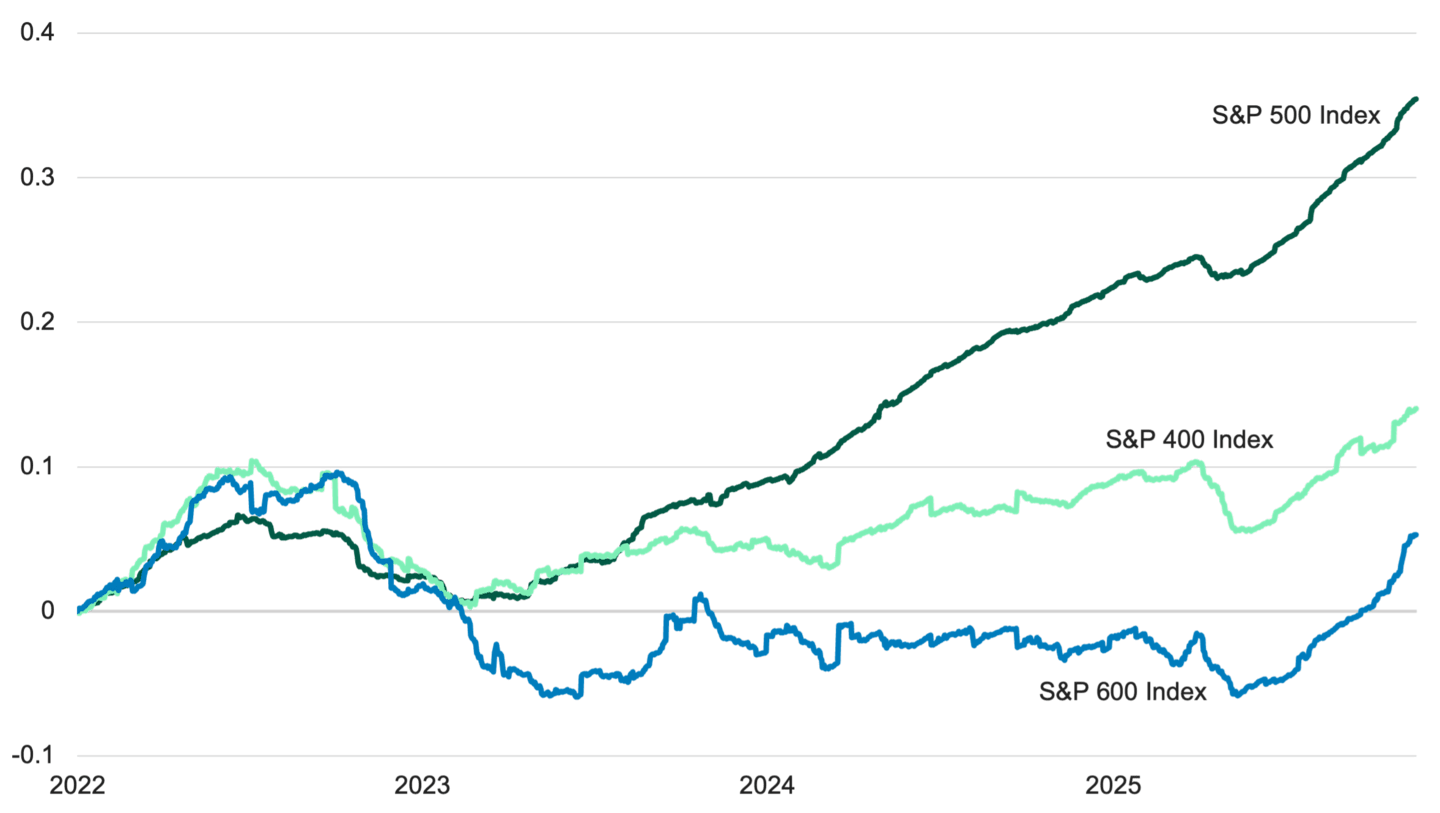AI, Consumer Spending Help Power Q3 Earnings
Earnings Watch: All regions reported earnings growth in the third quarter amid robust AI investment and resilient consumer spending.

Key Takeaways
More companies are benefiting from the artificial intelligence (AI) trend, not just the mega-cap tech firms.
The effect of higher tariffs appears more manageable after several months in the new trade environment.
Consumer spending still looks resilient, although low- and middle-income households show signs of weakness.
Across markets, corporate earnings gained ground during the third quarter as investments in AI, steady consumer spending and other factors supported growth.
Firms gained clarity about the real impact of higher tariffs, allowing them to adjust their operations as needed.
Earnings expectations for small and midsize companies also continued to tick upward, indicating a broadening of growth, as shown in Figure 1.
Figure 1 | Earnings Growth Expectations for Small, Midsize Companies Accelerates
Cumulative Daily Change in Next-12-Month (NTM) Earnings-Per-Share Estimates

Data from 1/3/2022 to 11/18/2025. Source: Bloomberg. Past performance is no guarantee of future results.
This quarter’s earnings highlights include:
Companies in the S&P 500® Index recorded positive earnings growth, and the majority of companies beat estimates for the quarter. Information technology, financials and utilities led results.1 Communication services, energy and consumer staples were the weakest sectors.
European companies reported weaker year-over-year earnings growth compared to the second quarter.2 Real estate, IT and financials were areas of strength. Utilities, consumer discretionary and industrials were the weakest.
Earnings growth improved in Japan, where communication services, utilities and IT were leaders.3 Health care, industrials and real estate were areas of weakness.
Emerging markets also experienced positive earnings growth led by IT, materials and health care.4 Real estate, consumer discretionary and consumer staples were the weakest sectors.
To gain a deeper understanding of the current market conditions and future expectations, explore our latest Investment Outlook.
Five Trends Impacting Q3 Earnings Growth
1. AI Spending Surges Among Leading Tech Firms
Spending on AI continues to drive earnings growth, and it’s helping a wider range of companies, not just the Magnificent Seven stocks.
According to analysts, data center construction is expected to attract trillions in spending over the next several years.5 While concerns have emerged about AI’s costs, companies like Alphabet and Meta plan to spend significantly more in 2026.6
What kinds of companies are benefiting?
CapEx spending is flowing to construction firms, utilities and other businesses involved in building AI infrastructure.
AI has also fueled an upswing in large mergers and acquisitions this year, creating opportunities for banks and other firms that facilitate these deals.7
You can see stronger growth in other regions, too, not just the U.S.
Earnings for European tech companies surged during the third quarter of 2025. For example, ASML and BE Semiconductor reported a surge in orders for their chipmaking machinery.8
2. Companies Adapt to New Tariff Environment
As ominous as tariffs looked this spring, many businesses appear to have avoided the worst outcomes, at least for now.
In the third quarter, U.S. earnings grew at the fastest rate since late 2021, as measured by the Russell 3000® Index.9 European and Japanese firms also performed better than expected.10
Many businesses are no longer discussing tariffs as frequently. S&P 500 companies mentioned the word “tariff” 33% less often during their third-quarter earnings calls.11
Why wasn’t the tariff impact worse?
The U.S. signed a series of new trade deals with lower rates — still higher than before, but better than originally announced.
Several countries started negotiating new agreements with each other, like the recent deal between the UK and India to lower tariffs.12
Many companies also gained more insight into how tariffs impacted their operations. They learned how much of the increased costs they could absorb and how much they needed to pass on to customers.
Of course, the situation could shift yet again.
The U.S. Supreme Court is evaluating whether the Trump administration overstepped its authority in implementing those tariffs. If the justices decide against the White House, it could create more uncertainty in the business climate.
3. High-Income Households Drive U.S. Consumer Spending
In our view, U.S. consumer spending increasingly reflects a K-shaped economy. The fortunes of high-income households are trending upward while less wealthy ones look wobblier.
The University of Michigan reported a nearly 30% year-over-year drop in consumer sentiment in November. Sentiment worsened across age, income and political affiliation.13
Only one group defied the trend. Sentiment rose 11% among the third of the U.S. population that owns the most stocks.
Visa said that consumers overall remained resilient, with U.S. payment volumes increasing by 8% in the most recent quarter.14 However, the biggest growth could be seen among the highest-spending group.
Likewise, American Airlines noted that its revenue from premium seating continued to outpace less-expensive options.15
More brands are reporting signs of trouble among low- and middle-income consumers. Fast-casual restaurants Cava and Chipotle are especially concerned about younger guests.16
Not everyone is suffering, though. Brinker International, the owner of Chili’s restaurants, reported growth in sales and traffic.17 The CEO said his company has worked hard to position itself as offering better value to customers.
“Our customer base is very representative of the U.S. consumer across all income cohorts, but our cohort growing the fastest is actually now households with income under $60,000.”
Kevin Hochman, CEO and Director – Brinker International
4. European Banks Show Earnings Strength
Banks aren’t usually known as high-growth businesses, but many European firms are enjoying a strong year.
Barclays, for example, has upgraded its 2025 guidance and plans to conduct quarterly stock buybacks.18 Société Générale, another firm that has offered buybacks, says it’s seeing results from its laser focus on controlling costs.19
Net interest margins and earnings for many banks continue to expand despite multiple interest rate cuts by the European Central Bank and the Bank of England.
Lower rates can compress banks’ profit margins. However, they also make borrowing more affordable for clients, which could boost demand for lending products. The European Central Bank says demand is improving, although it remains relatively weak.20
Of course, lending isn’t the only way that banks earn money. Revenues from wealth management operations have seen an uptick in 2025, according to research firm CFRA.21
5. Japan’s Government Initiatives Push for Growth
Japan’s economy stumbled in the most recent quarter, shrinking for the first time in six quarters.22 The government is already developing a new set of policies to promote growth.
Japan’s new prime minister has signaled support for key industries, including AI, semiconductors, quantum computing, shipbuilding and others.23
The government has announced a stimulus package worth roughly $135 billion.24
Officials are also considering tax cuts to promote more business investment and household spending.25
Japan has negotiated smaller tariffs with the U.S., bringing rates from 25% down to 15%.26
These measures build on Japan’s ongoing digitalization movement. This nationwide initiative is pushing government bodies and businesses to modernize their technology.
Leaders are betting that better tech will streamline operations, making Japan overall more efficient and competitive.
Earnings Forecast: EM and U.S. Expected to Lead Growth
Analysts are expecting S&P 500 earnings growth of 7.19% in the fourth quarter and 11.72% growth for all of 2025.27
Forecasts call for European earnings growth of 0.61% in the fourth quarter and 1.48% for the full year.28 In Japan, analysts predict negative earnings growth of 6.91% next quarter, but 2.49% positive growth for the year.29
Emerging markets are expected to produce earnings growth of 16.21% in the last quarter of the year and 10.65% for the year.30
Authors
Senior Client Portfolio Manager
Senior Client Portfolio Manager
Learn More About Our Global Growth Strategies
We focus on investing in companies with accelerating growth characteristics and earnings power.
S&P 500 Index, as of 12/11/2025.
MSCI Europe Index, as of 12/11/2025.
MSCI Japan Index, as of 12/11/2025.
MSCI EM Index, as of 12/11/2025.
Erikhans Kok, Johan Rauer, and Pankau Sacheva, et al., “Scaling Bigger, Faster, Cheaper Data Centers with Smarter Designs,” McKinsey & Co., August 1, 2025; Robin Wigglesworth, “‘The Global Data Centre and AI Build-Out Will Be an Extraordinary and Sustained Capital Markets Event,’” Financial Times, November 11, 2025.
FactSet, Transcripts - Alphabet Q3 2025 Earnings Call and Meta Q3 2025 Earnings Call, October 29, 2025.
PwC, “AI and Private Equity Fuel Surge in Large M&A Deals,” September 15, 2025.
Chloe Meley, “Europe’s Tech Sector Outperforms as AI Boom Bolsters Demand,” Bloomberg, October 27, 2025.
George Steer, “Corporate America Posts Best Earnings in 4 years Despite Tariffs,” Financial Times, November 8, 2025.
Javi West Larrañaga, “European Corporate Outlook Improves as Companies Defy Uncertainty,” Reuters, November 11, 2025; Aya Wagatsuma and Kentaro Tsutsumi, “Japan Earnings Beating Expectations Point to Rally Going Further,” Bloomberg, November 10, 2025.
FactSet, “33% Decline in the Number of S&P 500 Earnings Calls Citing 'Tariffs' for Q3 vs. Q2,” November 14, 2025.
UK Department for Business & Trade, “UK-India Trade Deal: Conclusion Agreement Summary,” July 24, 2025.
University of Michigan, Survey of Consumers – Preliminary Results of November 2025, November 7, 2025.
FactSet, Transcript – Visa Q4 2025 Earnings Call, October 28, 2025.
FactSet, Transcript – American Airlines Q3 2025 Earnings Call, October 23, 2025.
FactSet, Transcript – Cava Q3 2025 Earnings Call, November 4, 2025; Transcript – Chipotle Q3 2025 Earnings Call, October 29, 2025.
FactSet, Transcript – Brinker International Q1 2026 Earnings Call, October 29, 2025.
FactSet, Transcript – Barclays Q3 2025 Earnings Call, October 22, 2025.
FactSet, Transcript – Société Générale Q3 2025 Earnings Call, October 30, 2025.
European Central Bank, “The Euro Area Bank Lending Survey – Third Quarter of 2025,” October 28, 2025.
CFRA, “European Banks: Can the 2025 Rally Extend Further?” August 25, 2025.
Cabinet Office, Government of Japan, “Quarterly Estimates of GDP for July – September 2025 (First Preliminary Estimates),” November 17, 2025; Megumi Fujikawa, “Japan’s Economy Contracts for First Time in Six Quarters,” Wall Street Journal, November 16, 2025.
Prime Minister’s Office of Japan, “Policy Speech by Prime Minister TAKAICHI Sanae to the 219th Session of the Diet,” October 24, 2025.
Megumi Fujikawa, “Japan Approves $135 Billion Stimulus Shot to Help Households, Economy,” The Wall Street Journal, November 21, 2025.
Nikkei, “Tax Cuts Are the First to Promote High City Finances, Aiming to Promote Growth Investment - The Liberal Democratic Party Holds a General Meeting of the Tax Survey Within the Week,” November 17, 2025.
The White House, “Fact Sheet: President Donald J. Trump Implements A Historic U.S.-Japan Framework Agreement,” September 5, 2025.
S&P 500 Index, as of 12/11/2025.
MSCI Europe Index, as of 12/11/2025.
MSCI Japan Index, as of 12/11/2025.
MSCI EM Index, as of 12/11/2025.
Forecasts are not a reliable indicator of future performance.
The opinions expressed are those of American Century Investments (or the portfolio manager) and are no guarantee of the future performance of any American Century Investments portfolio. This material has been prepared for educational purposes only. It is not intended to provide, and should not be relied upon for, investment, accounting, legal or tax advice.
The information is not intended as a personalized recommendation or fiduciary advice and should not be relied upon for investment, accounting, legal or tax advice.
References to specific securities are for illustrative purposes only and are not intended as recommendations to purchase or sell securities. Opinions and estimates offered constitute our judgment and, along with other portfolio data, are subject to change without notice.
No offer of any security is made hereby. This material is provided for informational purposes only and does not constitute a recommendation of any investment strategy or product described herein. This material is directed to professional/institutional clients only and should not be relied upon by retail investors or the public. The content of this document has not been reviewed by any regulatory authority.
©2025 Standard & Poor's Financial Services LLC. The S&P 500® Index is composed of 500 selected common stocks most of which are listed on the New York Stock Exchange. It is not an investment product available for purchase.